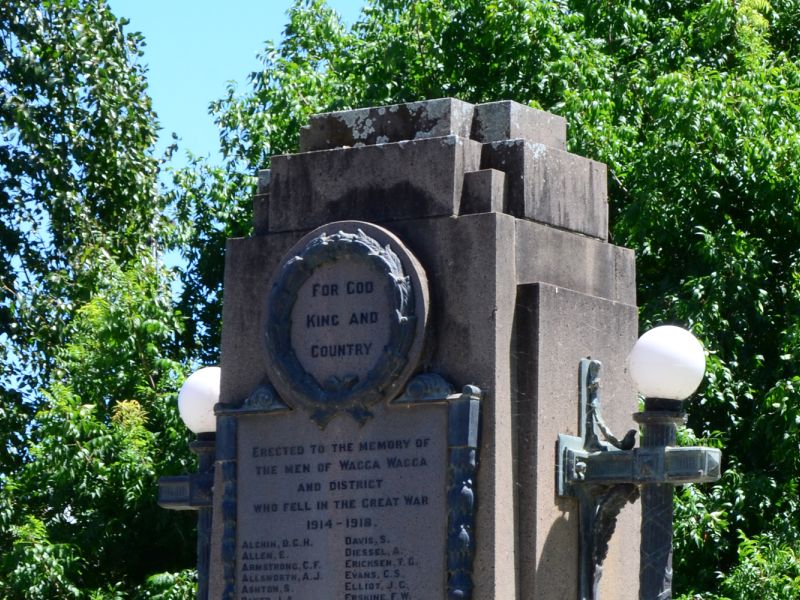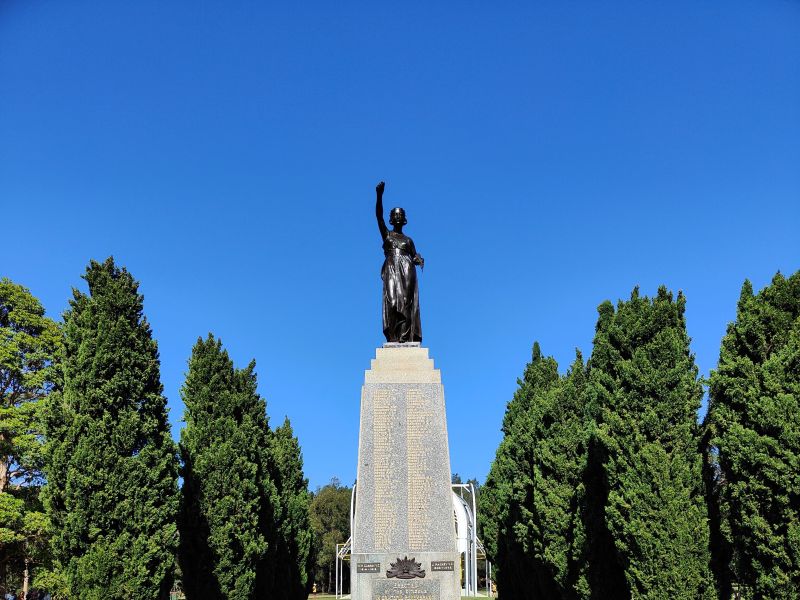John George Walton
Jack was born at the Rock, a small rural town just over 30 km from Wagga Wagga in NSW, in 1885. He was one of eleven children to Robert and Emma Florence (née Goodwin). The family had just moved to this area, having lived near Stawell in Victoria’s west, where the first of their eight children had been born. One of Jack’s brothers, Charles, had died when Jack was six and Charles only one. Three years later, Jack’s mother, Emma, passed away in 1894.
Jack’s earlier education was at the Wagga Wagga Public School. After leaving school he gained an apprenticeship as a jeweller with J McGowan, at Coolamon, NSW, about 40 km north-west of Wagga Wagga. He remained with McGowan for six years before heading off on his own.
Travelling around the countryside, Jack found himself at Corryong. Articles in the Ovens and Murray Advertiser of 1907 provide us with an indication of Jack’s love of music and theatre.
14th September 1907
“At a poster ball held at Corryong last week the most original costume prize, lady and gentleman, was won by Mr. J. Walton and his wife (Mr L. Trapman), who were dressed in hessian, as the result of the tariff [the newly introduced Customs Tariff of 1907].”
14th December 1907
“The local dramatic club [of Corryong] staged the well-known drama “Aurora Floyd” on Friday. There was a very fair house and the play was well received …Messrs . Edwards, P. C. Hale, J. Walton, H Taylor and J. Hillard all acquitted themselves admirably …”
On the 12th of August 1915 Jack signed his enlistment papers at the Melbourne Recruiting Depot. He became Private J.G. Walton, Regimental Number 3962 of the 9th Reinforcements for the 23rd Battalion, 6th Brigade, 2nd Australian Division. He spent the first month of his enlistment at the 22nd Depot Battalion before transferring to the 4th Depot Battalion at Royal Park. Murray McKay sent an article to the Corryong Courier which was published on the 16th September 1915 listing those from the Upper Murray that were with him in camp. From Corryong they included Hugh Hamilton, Hugh Waters, Claude Robinson, Hugh Taylor, Jack Walton, Alex Waters, Guy Bailey and Geoff Bailey. Three of these men would never return to Corryong. Jack spent a further two weeks at the 5th Depot Battalion before being transferred to the 14th Reinforcements for the 23rd Battalion, stationed at the Broadmeadows Camp near Melbourne, Victoria.
One of Jack’s older brothers, Robert Francis, also enlisted in the 1st AIF, in the 55th Battalion. Although he was wounded twice during his service, he returned home in 1919.
It was well into the new year, on the 8th day of February 1916 that Jack and his unit embarked on HMAT Oriana at Port Melbourne and proceeded overseas. They arrived at Alexandria on the 21st of March and spent one week ashore before embarking on another troopship to take them the final part of the journey to the Port of Marseilles in the south of France. For a period of three months the troops spent time at the 2nd Division Base at Etaples, undergoing more training for trench warfare at the front. Jack was finally taken on strength with the 23rd Battalion in the field at Rue de Bois, near the French-Belgium border on the first day of July.
Within a month, Jack had been wounded in action with a shell wound to the right arm. He was taken to the 44th Casualty Clearing Station before being loaded onto No. 11 Ambulance Train. Two days were spent at the 4th General Hospital at Camiers before it was decided that Jack’s wound was serious enough for him to be taken to a hospital back in England. He embarked on HS Cambria at Calais and by the end of the day had been admitted to the 1st West General Hospital at Fazakerley, Liverpool. Jack would remain here until the 12th of November when he embarked on the S.S. Victoria and returned to France, joining the 6th Training Battalion at Etaples. He rejoined his unit in the field on the 6th of December.
The winter of 1916/1917 in Europe was one of the coldest for decades. The trenches provided no protection from the bitter winter. Abnormally low temperatures, especially at night, froze clothes and blankets. The previously wet weeks had left the area a sea of slushy mud. Trench foot, caused by prolonged standing in cold and dirty water, without changing boots or socks, affected thousands of troops, on both sides of No Man’s Land. It was no surprise when Jack was admitted to the 13th Australian Field Ambulance with influenza on the 3rd of February. Within less than a week he entrained on the 5th Ambulance Train and was admitted to the 12th General Hospital. Jack’s illness developed further into bronchitis and he would remain in hospital until the 12th of April. He was then given a two week furlough, although there are no records to say what he did or where he went during this rest period. Upon arriving back he was classified as B1A, someone who was capable of garrison duty overseas. He spent his final four weeks resting up, regaining his strength until making his way up to some basic training.
On the 14th of October 1917, Jack proceeded overseas to France, finally rejoining his unit on the 19th of October. The new year once again saw him in poor health and he was admitted to the 6th Australian Field Ambulance suffering from scabies. A week in hospital saw him with sufficient health to rejoin his unit in Belgium on the 27th of February 1918.
Towards the end of August 1918, the 2nd and 5th Australian Divisions were preparing for the assault on Mont St Quentin and Péronne. The village of Péronne was bordered on its southern and western edges by the Somme River. The village was heavily fortified by the Germans. The village of Mont St Quentin was seen by the Allies as the key to Péronne. It itself stood at the top of a gentle slope and was a nest of trenches, machine guns and sentry positions manned by German soldiers who had volunteered to defend the Mont.
In the early hours of the 31st of August, 5th Brigade of the 2nd Division set off on the initial assault of the Mont. By nightfall they held a line on the south-western outskirts and had a foothold in the village. The brigade had taken nearly 400 casualties. The following day it was the turn of the 6th Brigade of the 2nd Division to enter the attack. The 23rd Battalion was in the lead. Upon reaching the area of Park Wood they came under intense machine gun attack. It was at this stage of the fighting that Jack was hit.
An account from Jack’s Australian Red Cross Society Wounded and Missing Enquiry Bureau files inform us of Jack’s last moments.
“At Mont St. Quentin, in the wood carrying machine guns he ran across an opening to get through; they were waiting for him and he was killed by machine gun. I was quite close to him, saw sparks fly off his helmet, he put his hand up to shield his face; hand was almost cut off. I did not see grave, but he was buried near Headquarters and I saw his cross ready to be put up.
Informant:- 7218 Cox, Ward 8, Harefield”
Jack was initially buried in the Clery British Cemetery, 23/4 miles north-west of Perone. After the war he was reinterred in the Hem Farm Military Cemetery, Hem-Monacu, France. Jack is remembered on the Australian War Memorial Roll of Honour, the Leichhardt War Memorial, the Wagga Wagga Cenotaph, and the Corryong War Memorial. For his service, he was awarded the British War Medal and the Victory Medal.
General Lord Rowlinson, General Officer Commanding the British Fourth Army, of which the 2nd and 5th Australian Divisions were part of, claimed after the battle;
“The capture of Mont St Quentin by the Second [Australian] Division is a feat of arms worthy of the highest praise. The natural strength of the position is immense and the tactical value of it in reference to Péronne and the whole system of the Péronne defences cannot be overestimated.
I am filled with admiration at the gallantry and surpassing daring of the Second Division in winning this important fortress, and I congratulate the with all my heart.”
 Stephen Learmonth
Stephen Learmonth

